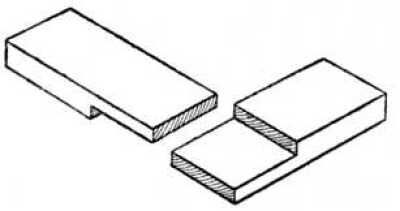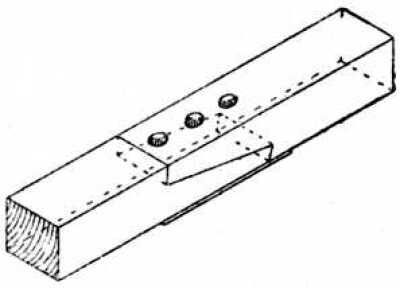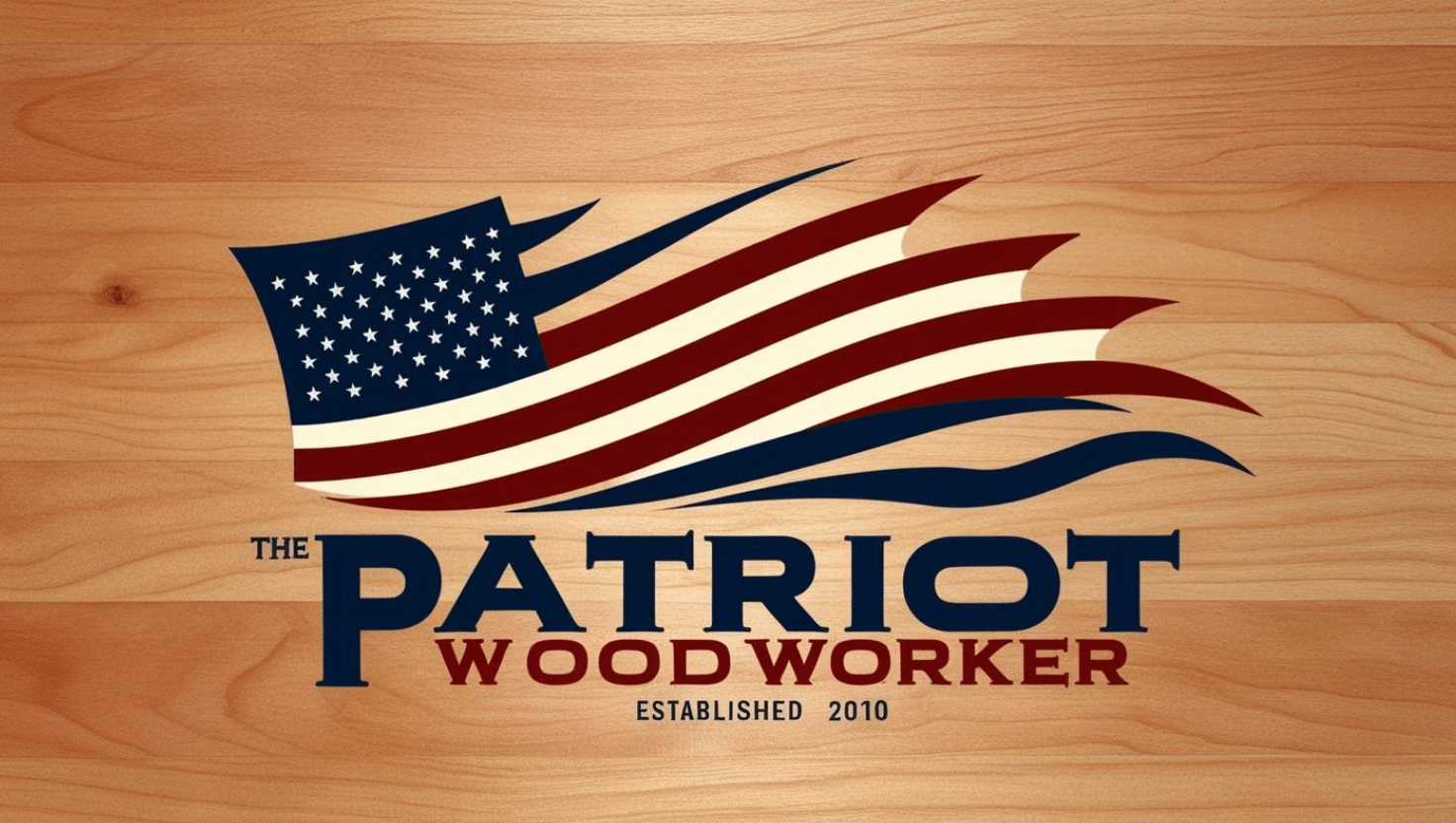Instructions
Welcome to our Glossary of Woodworking Joints. Feel free to edit and add terminology to this research page. Please follow the general guidelines as outlined below.
- Add only woodworking terminology that is widely used in the crafts, arts, trades and industry of woodworking.
- Avoid entering terminology that is used locally, or regionally.
- Please research your own entries, before entering them here, and verify that they are indeed accurate and reliable.
A
B
Biscuit Joint - Crescent-shaped slots are carved into 2 pieces of wood, then an oval-shaped "biscuit" is glued into place to join them both. Keeps glued boards aligned while glue dries and strengthens the bond. Cut perfect biscuit slots with our Biscuit Jointers.

Box - A corner joint with interlocking square fingers. Receives pressure from two directions.
Bridle - The bridle joint is often defined as the reverse of a mortise and tenon, and is chiefly used in the carpentry and joinery trades. The name probably originated from the fact that it bears some resemblance to the manner in which a bit slips into the horse's mouth and is fastened to the bridle. Like Mortise and Tenon, but easier to make as it is open on three ends.

Butt - The end of a piece of wood is butted against another piece of wood. This is the simplest and weakest joint. Of those, there is the a) T-butt, b) end-to-end butt, c) Miter butt and d) edge-to-edge butt.
C
D
Dovetail - See various types of Dovetail joinery below:
Through - A Through joint is where the end grain is visible from both boards. Through dovetail joints are most commonly used on box construction and carcass (framework of the piece). This joint is also called a plain dovetail by many in the woodworking community. In the past the ends showing through would have been masked by a veneer. Today they are a sign of exceptional quality and are left showing with pride.

Half-blind - A half-blind dovetail joint also known as the single-lap dovetail joint is exactly opposite of a through joint because the end grain is not visible on the boards. Sockets house the tails at the end of the boards so the dovetail ends are invisible. Half-blind dovetail joints are commonly used for attaching drawer fronts.

Secret mitered - A secret mitered joint is also know as a full-blind mitered dovetail and full-blind dovetail joint. Secret mitered joints are used in box work and cabinet construction and offers the best strength out of all of the dovetail joints. These joints are used for box work or fine cabinet construction where strength is needed without a joint you can see.

Secret double-lapped - The secret double-lapped dovetail joint is kind of the like the mitered joint but has a visible section of end grain on a single edge of the joint. similar to the secret mitered dovetail, but presents a very thin section of end grain on one edge of the joint. Secret double-lapped joints are used for box construction and carcass construction to hid the dovetails.
Sliding - The sliding dovetail joint is created by joining two wood boards at 90 degree angles, where the they intersect different than other types of dovetail joints. They intersect by sliding the tail of one board into the middle socket of the other. Sliding dovetail joints are commonly referred to French Dovetail joints. Sliding joints are commonly used to joint cabinet sides to shelves, sides to cabinet bottoms, shelves to horizontal partitions, table frames to adjacent sections, sides to drawer fronts, cabinet sides to front rails, body and neck in guitars and violins.

Doweling - Doweling is the term generally given to the method of jointing timber and other materials by wooden or metal pegs, which are called dowels. For cabinet-making and similar work straight-grained beechwood dowels are mostly used; these may be bought by the gross, in lengths of about 36 ins., and of any desired diameter. Draw bore - The draw bore joint method of joinery is typically used in a mortise and tenon joint. Some times in order to add additional strength to a mortise and tenon joint the crafts-person will bore through the joint and add a pegs or dowels to secure the tenon to the mortise, going a step further, one would also bore a hole(s) in the mortised part, then bore a hole(s) in the tenoned part that are offset slightly, then insert and ram home a trenail or trunnel pin, the tenoned part will draw tightly into the mortise.

Doweling Joint
E
Edge Joint - Used to connect 2 boards along their length. Edge joints are usually glued, and are made stronger with complementary interlocking protrusions. The profile expands the edge-to-edge glue surface, but more importantly, produces the precise surface alignment that’s essential for fast glueups.

F
Finger Joint - (also known as a comb joint)
A woodworking joint made by cutting a set of complementary rectangular cuts in two pieces of wood, which are then glued. To visualize a finger joint simply interlock the fingers of your hands at a ninety degree angle; hence the name "finger joint." It is stronger than a butt or lap joint, and often forms part of the overall look of the piece.

G
Glued - The glued joint is made by planing two pieces of timber so that when placed together they are in contact with each other at every point; they are then usually united with glue. Alternative names under which it is known are the butt joint, the rubbed joint, the slipped joint, whilst in certain localities it is known as the slaped (pronounced slayped) joint.

Glued Joint
H
Halved - The halved joint is frequently known as half-lapping, and sometimes as checking and half-checking. In the majority of cases it is made by halving the two pieces, i.e., by cutting half the depth of the wood away. There are, however, exceptions to this rule, as in the case of "three-piece halving" (or, as it is sometimes called, "third lapping") and in the halving of timber with rebated or moulded edges. Halving is one of the simplest methods of connecting two pieces of timber, especially where it is desired to make frames and bracket supports for either inside or outside use.

Halved Joint
L
Lap - or Halfing Joint - The end of a piece of wood is laid over and connected to another piece of wood. Due to a large surface area of long-grain to long-grain wood and glue surface coverage, this is a very strong joint. There are many versions of the lap joint but they all involve removing half of the wood from each piece using a saw, chisel, or router. 1/2 of the wood material on both pieces is removed, weakening the joint somewhat, but the two boards are aligned flush and stable.

M
Mitering - The term mitering is generally used to denote the type of joint used at the corner of a picture frame; or where two pieces of wood are beveled away so as to fit each other, as the skirting or plinth mould. In these cases the timber is cut so that the joint is at 45 degrees to the face, and the two pieces, when placed together, form an angle of 90 degrees (a right angle).
Mortise and Tenon - A mortise (or mortice) and tenon joint is a type of joint that connects two pieces of wood or other material. Woodworkers around the world have used it for thousands of years to join pieces of wood, mainly when the adjoining pieces connect at an angle of 90°. In its basic form, it is both simple and strong.
Mortise

Corner Stub -
Foxtail -
Haunch -
Tenon
Bare Faced -
Feather -
Pinned -
Stubbed or Stump -
P
Pocket-hole - Simple to make and often seen on manufactured items as it is easy to reproduce using a jig. Drill holes at an angle to both pieces for a stronger joint. For very best results, use a Forstner bit, which are well known for their ability to drill clean and chip-free holes in wood.

S
Saddle - The "saddle joint" is used for connecting upright posts to heads or sills of framing, and undoubtedly takes its name from its similarity to the way in which the saddle fits the horse. It does not weaken the framing as does a mortise and tenon joint, and shrinkage has little effect upon the joint.

Saddle Joint
Scarf - The method known as "scarfing" is used for the joining of timber in the direction of its length, enabling the workman to produce a joint with a smooth or flush appearance on all its faces. One of the simplest forms of scarfed joint is known as the half lap, in which a portion is cut out at the end of each beam or joist, equal in depth to half the full depth of the beam, and of equal length to the required scarf.

Plated Sarf Joint
T
Tongued and Grooved - The tongued and grooved joint is used in one form or another throughout the whole of the woodworking trades, covering, as it does, a great variety of work from the laying of flooring boards to the construction of dressers, bookcases and other cabinet work. As the name of the joint implies, one one board a groove is created, on the joining board a tongue is created, and the two are married or matched together.

Tongue and Grooved Joint
Tambour Joint - A tambour joint is made with a ball and socket for joinery that allows movement between wood pieces, such as a roll-top desk or breadbox door. This joinery does not require glue or fasteners. The interlocking joint allows the joined pieces to move, flex, and move along a track.


.thumb.jpg.573d1497d0675219908c85aabefd797a.jpg)


Recommended Comments
Join the conversation
You are posting as a guest. If you have an account, sign in now to post with your account.
Note: Your post will require moderator approval before it will be visible.